Chinese Medicine Regulatory Office
Site Menu
Common methods for prevention of colds from Chinese medicine perspective
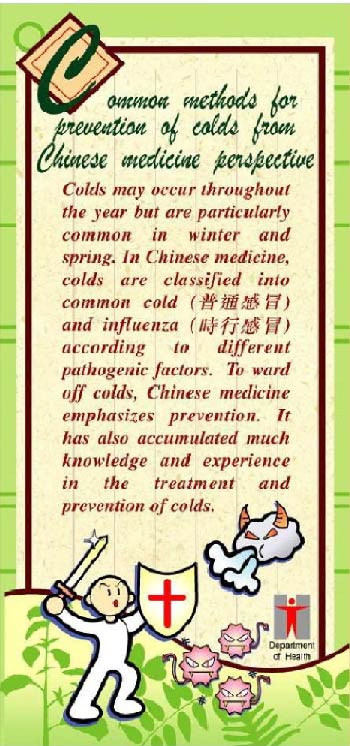
Common methods for prevention of colds from Chinese medicine perspective
Colds may occur throughout the year but are particularly common in winter and spring. In Chinese medicine, colds are classified into common cold (普通感冒) and influenza (時行感冒) according to different pathogenic factors. To ward off colds, Chinese medicine emphasizes prevention. It has also accumulated much knowledge and experience in the treatment and prevention of colds.
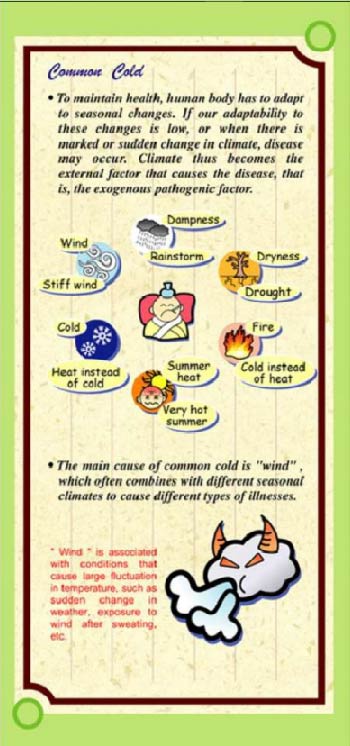
Common Cold
To maintain health, human body has to adapt to seasonal changes. If our adaptability to these changes is low, or when there is marked or sudden change in climate, disease may occur. Climate thus becomes the external factor that causes the disease, that is, the exogenous pathogenic factor.
Wind: Stiff wind, Cold: Heat instead of cold, Summer heat: very hot summer, Dampness: rainstorm, Dryness: Drought, Fire: cold instead of heat
The main cause of common cold is "wind", which often combines with different seasonal climates to cause different types of illnesses.
“Wind” is associated with conditions that cause large fluctuation in temperature, such as sudden change in weather, exposure to wind after sweating, etc.
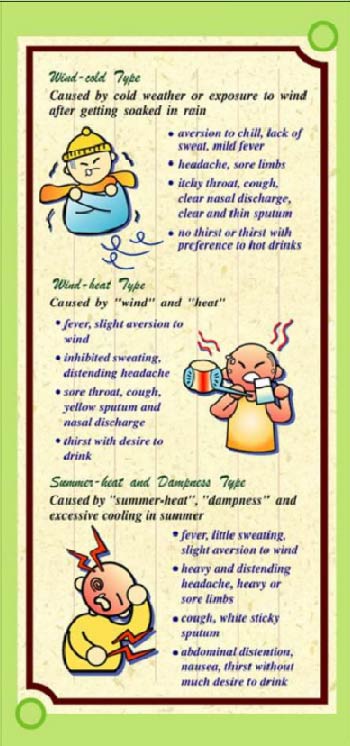
Wind-cold Type
Caused by cold weather or exposure to wind after getting soaked in rain
•aversion to chill, lack of sweat, mild fever
•headache, sore limbs
•itchy throat, cough, clear nasal discharge, clear and thin sputum
•no thirst or thirst with preference to hot drinks
Wind-heat Type
Caused by "wind" and "heat"
•fever, slight aversion to wind
•inhibited sweating, distending headache
•sore throat, cough, yellow sputum and nasal discharge
•thirst with desire to drink
Summer-heat and Dampness Type
Caused by "summer-heat", "dampness" and excessive cooling in summer
•fever, little sweating, slight aversion to wind
•heavy and distending headache, heavy or sore limbs
•cough, white sticky sputum
•abdominal distention, nausea, thirst without much desire to drink
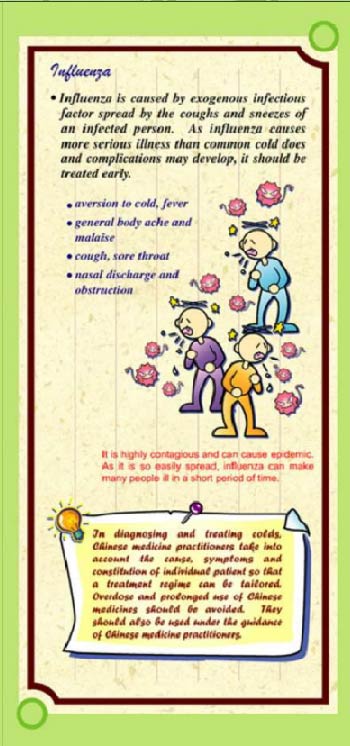
Influenza
Influenza is caused by exogenous infectious factor spread by the coughs and sneezes of an infected person. As influenza causes more serious illness than common cold does and complications may develop, it should be treated early.
•aversion to cold, fever
•general body ache and malaise
•cough, sore throat
•nasal discharge and obstruction
It is highly contagious and can cause epidemic. As it is so easily spread, influenza can make many people ill in a short period of time.
In diagnosing and treating colds, Chinese medicine practitioners take into account the cause, symptoms and constitution of individual patient so that a treatment regime can be tailored. Overdose and prolonged use of Chinese medicines should be avoided. They should also be used under the guidance of Chinese medicine practitioners.
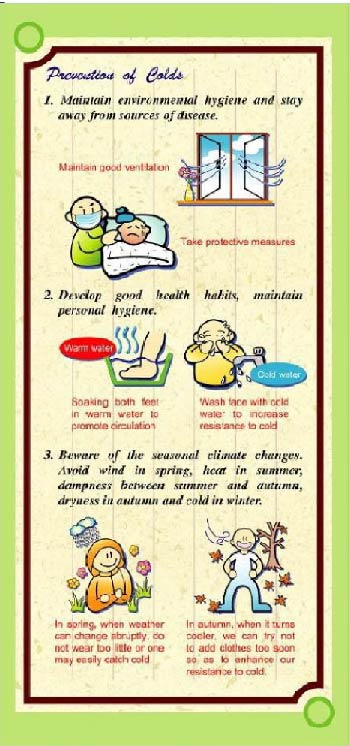
Prevention of Colds
1. Maintain environmental hygiene and stay away from sources of disease.
Maintain good ventilation
Take protective measures
2. Develop good health habits, maintain personal hygiene.
Warm water: soaking both feet in warm water to promote circulation
Cold water: wash face with cold water
to increase resistance to cold
3. Beware of the seasonal climate changes. Avoid wind in spring, heat in summer, dampness between summer and autumn, dryness in autumn and cold in winter.
In spring, when weather can change abruptly, do not wear too little or one may easily catch cold.
In autumn, when it turns cooler, we can try not to add clothes too soon so as to enhance our resistance to cold.
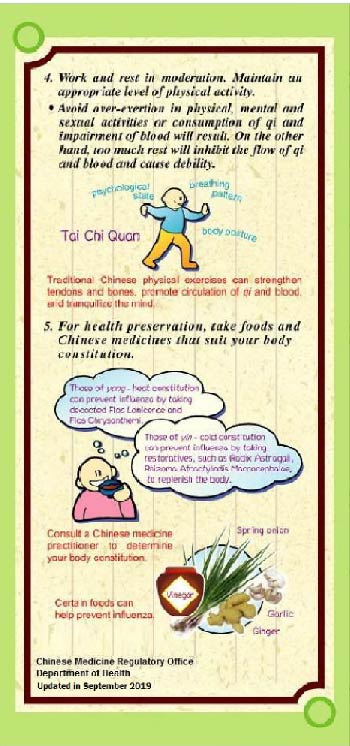
4. Work and rest in moderation. Maintain an appropriate level of physical activity.
•Avoid over-exertion in physical, mental and sexual activities or consumption of qi and impairment of blood will result. On the other hand, too much rest will inhibit the flow of qi and blood and cause debility.
Traditional Chinese physical exercises can strengthen tendons and bones, promote circulation of qi and blood, and tranquilize the mind.
5. For health preservation, take foods and Chinese medicines that suit your body constitution.
Consult a Chinese medicine practitioner to determine your body constitution.
(Those of yang – heat constitution can prevent influenza by taking decocted Flos Lonicerae and Flos Chrysanthemi.)
(Those of yin – cold constitution can prevent influenza by taking restoratives, such as Radix Astragali, Rhizoma Atractylodis Macrocephalae, to replenish the body.)
Certain foods can help prevent influenza, such as vinegar, spring onion, garlic and ginger
Chinese Medicine Regulatory Office
Department of Health
Website: www.cmro.gov.hk